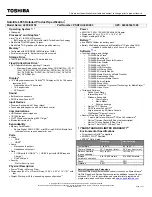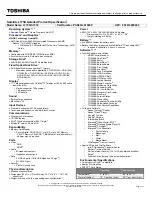
3
1. PCG-V505 Series Troubleshooting
8 DIGIT
PRODUCT
CODE
7 DIGIT
SERIAL
NUMBER
NOT CORRECT
MODEL
NUMBER
CORRECT MODEL NUMBER VIEWED
WHEN LCD PANEL OPEN
FIGURE 1-1 - DATA REQUIRED FOR WARRANTY CLAIM
Startup Problems
Failure of the computer to boot up to full operating condition can be caused by hardware, firmware, or software
failures. In most situations, the cause is apparent. Sometimes it may be obscure. Startup problems can be
classified into the following groups:
•
No Power
•
Power On Self-Test (POST)
•
Operating System Software
No Power
Since the regulation circuits required for notebook computers to operate are located on the AC adapter and the
motherboard, isolating the cause of a unit that will not power up is relatively simple. If the unit will power up with a
known good battery, this helps to determine if the AC adapter may be at fault. If the AC adapter outputs a voltage
that is excessively higher or lower than the specified voltage, a protection circuit located on the motherboard will
engage and prevent the onboard regulator circuits from applying power to the circuits. It is, therefore, important to
verify proper voltage levels generated by the AC adapter. The following voltages were recorded from a properly
operating AC adapter supplied with a PCG-V505DX.
•
Unloaded: 15.78VDC.
•
Connected to unit, power off, with fully charged battery: 15.73VDC.
•
Connected to unit, power off, with battery charging: 15.58VDC.
•
Connected to unit, power on: 15.25 to 15.45VDC (Varies by CPU and hard drive activity).
NOTE: The loaded voltage of the AC adapter can be checked by removing the keyboard. A white connector
located near the top left, having a black and red wire, provides power to the motherboard from the AC adapter.
If the AC adapter voltage is lower than 15 or greater than 16 volts, the UL Protect circuit on the motherboard
will latch and prevent the unit from powering up. This generates a symptom of a dead power supply on the






































